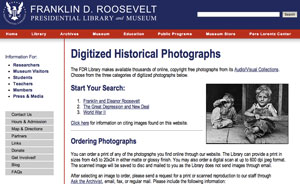talking history | syllabi | students | teachers | puzzle | about us
The Franklin D. Roosevelt Presidential Library and Museum Digital Archive
http://www.fdrlibrary.marist.edu/archives/collections.html
Created and maintained by the Franklin D. Roosevelt Library and Museum, Hyde Park, N.Y., in collaboration with Marist College and IBM.
Reviewed July 8, 2005.
The Franklin D. Roosevelt Presidential Library, in collaboration with Marist College and IBM, launched its digital library project in the early 1990s, becoming the first presidential library to enter the electronic arena. The digital archive has three components: printed text, audiovisual material and curriculum materials complementing the online archival material, and current library exhibitions.
The print section of the digital archive hosts approximately 23,500 pages, most of which come from the President’s Secretary’s File (PSF), the collection most frequently used by visiting scholars, and include the documents FDR secured in the White House safe as well as diplomatic material related to the United States' wartime relationship with Great Britain, the Vatican, and Germany. The index to each collection is thorough, clear, and easy to use, and, in most cases, an image of the original and a transcript of the document are available. Users click on a topic or collection they wish to review (Safe Files, Vatican Files, German Diplomatic Files, British Diplomatic Files); a summary of the collection appears from which readers may begin a keyword search or browse the finding aide, which summarizes the content of each folder contained in the collection. Viewers may then click on a folder title to review or access its contents. (Although this represents only a portion of the PSF, volunteers are working with archivists to complete the file’s digitization, digitizing the collection in numerical box order.)

Digital materials from the FDR Presidential Library
include the Digitized Historical Photographs collection.
While the PSF contains some material related to the New Deal, scholars and other users who wish to find depression-era material will find their selections more limited than those interested in Roosevelt’s diplomatic and wartime record. Instead, the archive offers a different document type, which is also useful for teachers and students—more than a thousand photographs of both Roosevelts and the era in which they lived, audio of all FDR’s Fireside Chats, transcripts of some of his most famous addresses, and video of FDR “walking.” K–12 and community college faculty will also find valuable classroom materials—ranging from The Roosevelt Rap to a Teaching with Documents Worksheet on the Educational Programs page.
The access is enticing and frustrating—enticing because it shows what can be done with funding and an innovative approach, and frustrating because the library houses such rich material that those who know it hope it would be as available as the popular psf collection. Unfortunately, it is not. Two issues deserve immediate attention. First, although the directory of digital finding aids lists several collections related to Franklin and Eleanor Roosevelt, they are not activated. Furthermore, the finding aids list only folder titles and the number of documents in each folder. Second, documents related to Eleanor Roosevelt are limited to one “My Day” column and a sample of her postwar correspondence with Harry S. Truman (which can be accessed only through the Truman Library). The library is aware of this, however, and is working closely with the Eleanor Roosevelt Papers Project to create an electronic corpus edition of almost eight thousand “My Day” columns.
Even with these glitches, the FDR Digital Archive sets the standard for their partners to follow.
Allida M. Black
George Washington University
Washington, D.C.
